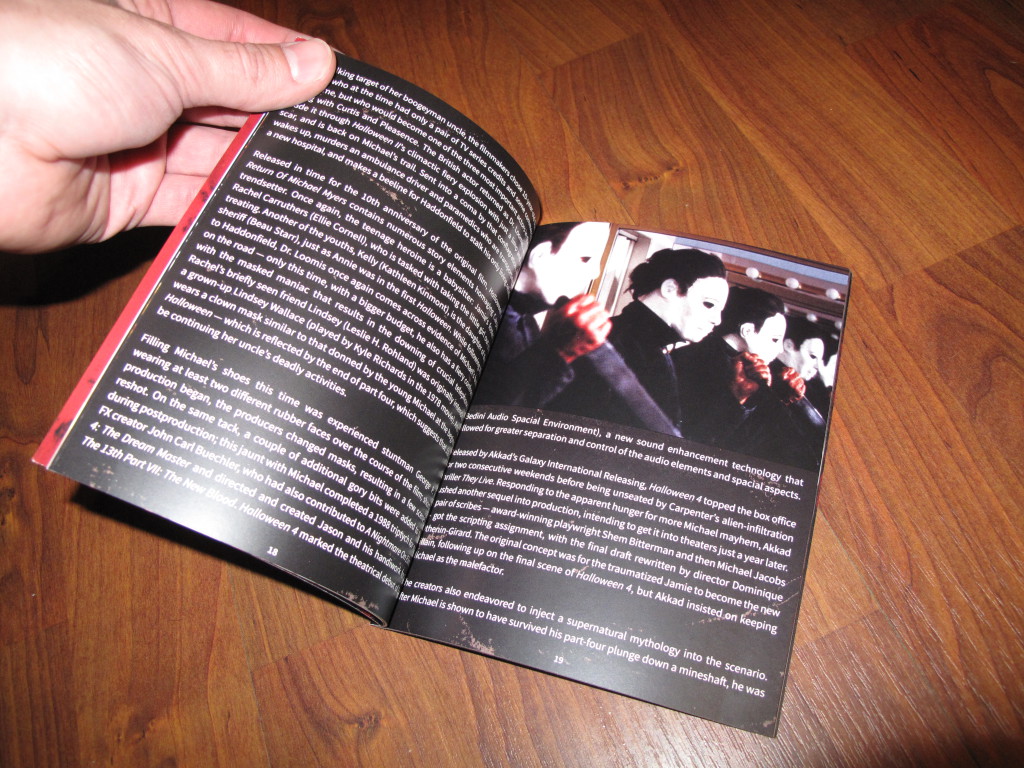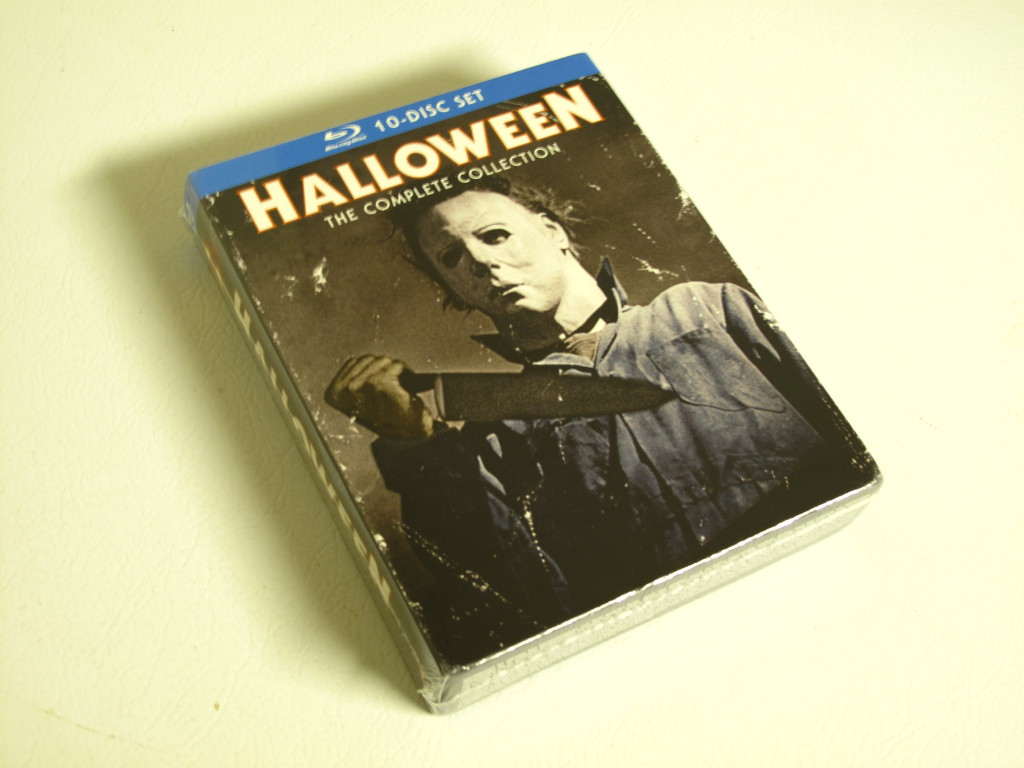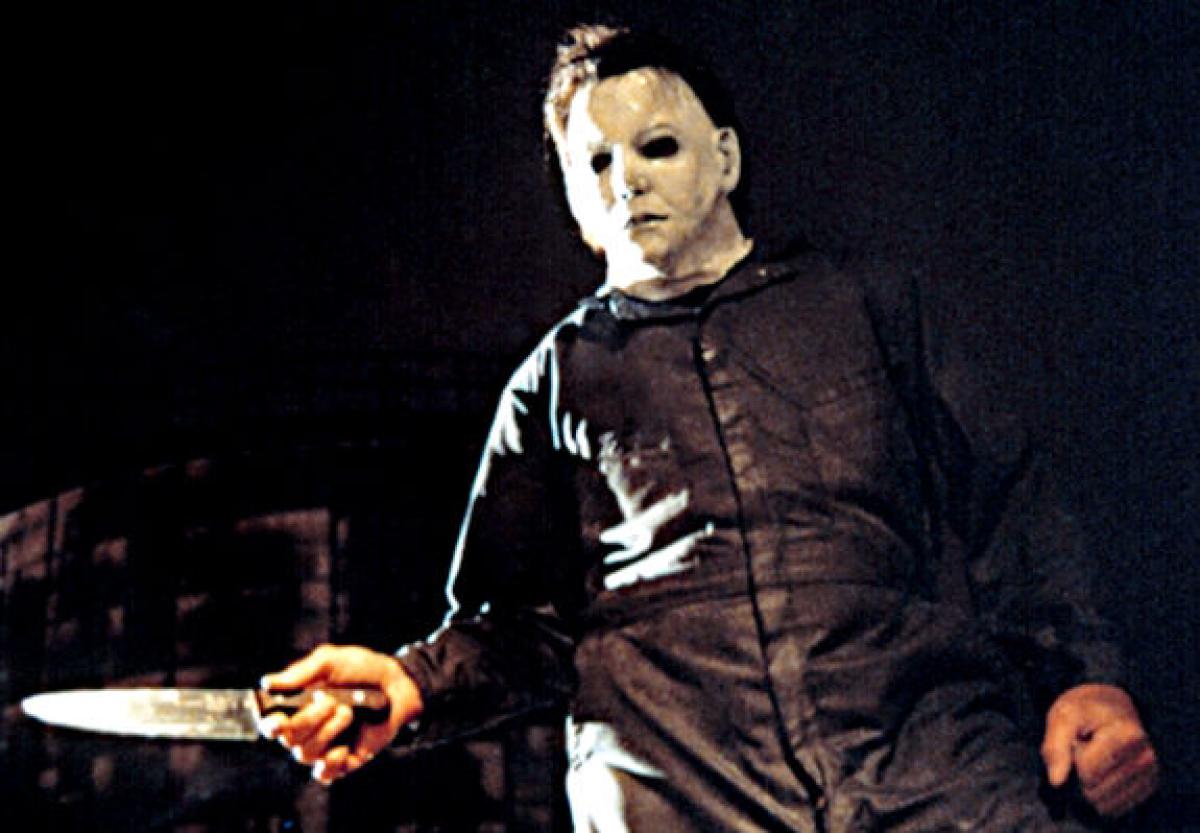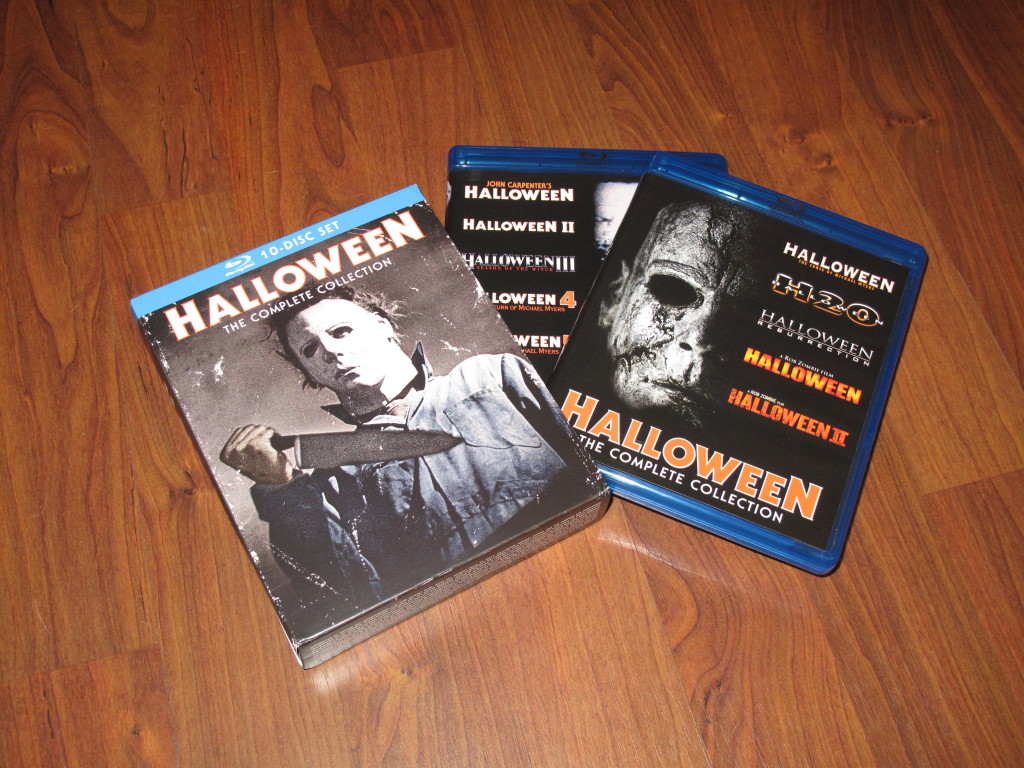Welcome to Haddonfield, a sleepy mid-western town where nothing of significance ever really happened until the night of October 31st, 1963. On that fateful night, for no discernible reason, 6-year old Michael Myers stabbed his 17-year-old sister to death in her bedroom. Fast forward to 1978. The house where the murder took place has become a local legend as haunted to the neighborhood children and Michael Myers has spent his life since in a mental institution in wait for the perfect moment to escape. When He finds his opportunity, Haddonfield falls victim to his own personal reign of terror for decades to come.
The Halloween franchise is one that no horror film fan can ignore, or dedicated film fan for that matter. When the first film opened in theaters in 1978, it proved to be one of the most innovative independent films in the history of the horror genre. It took no time at all to establish a cult following, and eventually become one of the most well established and influential series in the history of film.
The Halloween series is now available in both a 10 or 15 Disc Blu-ray boxed set. The 10 disc box set has all of the films included, but very little else than the basic special features you would find on a typical Blu-ray. The 15 disc box set includes the never before released producers cut of Halloween: The Curse of Michael Myers as well as the ultra-rare network TV version of the original Halloween, the network TV version of Halloween II, plus the unrated versions of Rob Zombie’s Halloween and Halloween II. It is also packed with hours of brand new bonus features including new interviews with cast and crew from the entire franchise. In response to years of fan feedback, the first Halloween now also includes the original mono audio track and the set includes both versions of the original Halloween, the original Blu-ray release and the recently remastered 35th Anniversary version with the mono track added back in. It also comes with a limited edition 40-page book written by Michael Gingold of Fangoria Magazine. The collectible packaging includes a newly commissioned illustration on the outer case and each film comes in its own black Blu-raycase with the original theatrical one sheet as the key art.

 Warning: The following reviews of each film contain spoilers, so proceed with caution if you are not familiar with the franchise and are interested in viewing what may be considered one of the greatest, most expansive group of stories in film history.
Warning: The following reviews of each film contain spoilers, so proceed with caution if you are not familiar with the franchise and are interested in viewing what may be considered one of the greatest, most expansive group of stories in film history.
Halloween (1978) – 5 out of 5
It is evident from the first ambitious sequence depicting young Michael Myers murdering his sister Judith, that John Carpenter had created something special in Halloween. This film was made at a time when there was practically no respect in the industry for horror films, and fans of the genre were scarce. Sure, the 1970s gave us classics like The Omen, Carrie, and The Exorcist, but these were all big studio releases based on bestselling novels. When Halloween was conceived, it was more than likely regarded at the same level of the exploitive grindhouse films of the day, and any notion it could succeed was unheard of. Given a very limited independent budget, John Carpenter took the helm in giving atmosphere to what began as the most basic of concepts: A madman on a murder spree. The audience is given very little reasoning behind Michael Myer’s motivations to terrorize 3 teenage girls while babysitting on Halloween night. However, it’s not the substance of the film that makes it remarkable, but the vision Carpenter brought, incorporating elaborate camera techniques, and a score he wrote himself to create an impending sense of tension throughout the story. There is a noticeable Influence of Alfred Hitchcock, who was the first to bring Horror to the environment into the modern era successfully. Although a good portion of the cast were friends of Carpenter’s working virtually for free (yeah, there’s some pitiful acting in there), the characters of Laurie Strode (Jamie Lee Curtis) and Doctor Samuel Loomis (Donald Pleasance) were executed with elegance and precision. While Jamie Lee Curtis gave a great career launching performance, branding herself as “The Scream Queen”, it was the addition of established British actor Donald Pleasance that brought this film together. The character had an unparalleled intensity and drive, bringing a truly infallible nemesis to go head-to-head against the pure evil Michael Myers represented. This film not only kicked off decades worth of sequels and remakes that are still being produced today, but it also redefined the genre, sparking the creation of many other horror franchises through the 1980s.
Halloween II (1981) – 3.5 out of 5
With the success of Halloween, a sequel was inevitable. Although he did not direct this time, John Carpenter came back to co-write the script. Not relying on tone as much as it’s predecessor, this film has more to do with body count, and elaborate ways Michael Myers could dispatch his victims. Clearly not as good as the original, I did enjoy Carpenter’s decision to start the film right at the moment the previous story ended and expand on the very same Halloween night. After enduring a series of injuries in her fight against Michael, Laurie (again played by Curtis) is now terrorized within the Hospital where she is receiving care. The real downfall in the choice of using the hospital as a setting is that it just didn’t work with the tone the first film established. They did what they could by making the hospital dark and understaffed, but that odd environment just pulled the audience out of the moments that could have otherwise been better executed under different conditions. The film did manage to expand on the story, revealing that Michael Myers and Laurie Strode are brother and sister, and his pursuit of her is driven by a dark instinct to murder members of his own family.
Halloween III: Season of the Witch (1982) – 1 out of 5
I can make a good argument that this is quite possibly the worst horror movie ever made, but for that very reason the film is worth watching for any fan. After clearly finishing off the killer Micheal Myers in Halloween II, the decision was made by the studio to move on to another Halloween based story, this time breaking away from the basic murder spree concept, and moving in the direction af a bizarre corporation’s conspiracy to murder all of the children across country on Halloween night through an ancient druid magic. Did I mention there’s an army of android supermen too? On top of being a remarkably ludicrous story, the script and acting is comparable to that of low-budget pornography of the era. Although absurdly awful, witnessing a train wreck of this magnitude has an entertainment value unto itself.
Halloween 4: The Return of Michael Myers (1988) – 3.5 out of 5
With the epic failure of Halloween III behind them, there’s no surprise the studio chose to go back to the basics and bring Michael Myers back. Now, many years later, the torch is passed on to Laurie Strode’s orphaned daughter, Jaime, to face the terror of Michael Myers, again on Halloween night. Made ten years after the original, a large fan base of younger horror film viewers had emerged from the success of other franchises, so I can’t contest the choice to have the audience perceive the terror of Michael through the eyes of a 10-year-old. Great effort was made in the production of this film to bring the impact of the original back to the masses, and there were a lot of noticeable parallels all the way up to the twist ending. This was not a bad re-boot of what was earlier regarded as a completed series.
Halloween 5 (1989) – 2.5 out of 5
One year after the events of Halloween 4, Jamie is still alive, but mentally she’s sustained enough psychological trauma to send her to the psych ward. A lot of odd decisions were made in the scripting and direction of this movie. Donald Pleasance returns as Doctor Loomis, but this time his character is much darker, and hardened by his history with Michael. Jamie is no longer speaking because of her mental issues, which gets annoying quickly with scenes that remind you of Lassie trying to get the attention of humans. She’s also developed the psychic ability to sense the danger Michael imposes on other people, which is weird given this is the 4th Michael Myers film and the first time we see this sort of supernatural phenomenon. An attempt to add comedy relief through quirky sound effects and two dopey policemen really drew back from what could have been a more suspenseful story, and there is an unknown character wearing a dark trench coat walking around Haddonfield whose purpose is never fully explained. I’d say this film is half a disaster due to its odd nature in direction, but still a decently suspenseful chapter in the series once you get into that final act.
Halloween: The Curse of Michael Myers (1995) – 2 out of 5
This film was made in a period when the entire horror industry had pretty much lost its way. During the 1980s, the films throughout the genre progressively became more formulaic. Any new ventures were, at this point, desperately seeking ways to re-discover a nitch to catch the eye of a new generation of fans. This time around, the character Tommy Doyle (Paul Rudd, before he found his comedic chops in movies like Anchorman…seriously), has grown up since being babysat by Laurie in the original film and become obsessed with Michael Myers. As it turns out, there is a new Myers baby, and Michael gets that old urge to hunt down and murder another member of his own family. This film made a large attempt to bring the origin story of Michael to the audience, and we discover that Michael’s murderous tendencies are the result of experimentation by a cult working within the Smith’s Grove Sanitarium where he spent his childhood. This is also the last time Donald Pleasance would revive his role as Doctor Loomis, as he passed away that same year. As always, Pleasence played the character with excellence, but sadly the script didn’t give him much to work with. Some other poor choices in casting and script writing detracted from what could have been a decent origin story to bring the films full circle on this particular venture.
Halloween H2O: 20 Years Later (1998) – 4 out of 5
Now that the air has cleared, and we’ve learned the source behind Michael’s motivations, the studio found a way to re-invigorate the Halloween franchise 20 years after its original release. This was also a time when the horror genre was going through a renaissance, utilizing fresh young actors, solid budgets, and producing good old-fashioned Friday night popcorn films for the next generation to enjoy. Because there were just too many loose ends from the previous film to attempt to make any sense of, the studio decided it was time to approach the film as though the previous four films simply did not exist. Jamie Lee Curtis revives her role as Laurie, having lived in secrecy in an attempt to live out her life free of the threat Michael imposed on her so many years before. In that time, she has also raised a son played by newcomer, Josh Hartnet. Now a seasoned actress, Curtis did a stupendous job of bringing back the aggressive fight in the character that launched her career. The direction of the film was well thought out and balanced, and it re-invented the tone that many of us fell in love with the first time we viewed the original. This was a terrific comeback for a series that could have easily withered and died like most of the other horror franchises that enjoyed success in the 1980s. There is a good argument to be made that this film was the keystone of the series, and without its existence, we may have never seen any later collaborations.
Halloween – Resurrection (2002) – 2 out of 5
The film opens with Laurie, now herself seemingly driven to madness, in a mental institution after accidentally killing the wrong man, thinking he was Michael at the end of H2O. Michael finds her and kills her, completing the task he set out on so many years before. It’s a great showdown to witness, but a bitter-sweet end to the character of Laurie. The real disappointment though, is that the book is closed on the Michael Myers’ story in the first fifteen minutes, and the rest of the movie has very little to do with anything of significance to the mythology. Following the horror production playbook of the time, Busta Rhymes and Tyra Banks were cast to play the roles of a creative team embarking on a new reality series that sends a group of teenagers into the Myers’ house on Halloween night where all is filmed for the world to see. A lot of people die at the hands of Micheal, as always. I don’t know whether to be entertained or annoyed at the fact that this is the last of the installments in the actual film series, and Micheal Myers is ultimately defeated by the hands of Busta Rhymes and his kung fu moves.
Halloween (2007) – 4.5 out of 5
When I heard there were plans in the works to re-make the original Halloween I cringed, but when I heard Rob Zombie was writing and directing I definitely perked up some. I’m a fan of just about everything he’s done, and on top of the list is the film House of 1000 Corpses, which I like to refer to as The Texas Chainsaw Massacre on hallucinogenic drugs. In this re-boot of the Halloween story, Zombie adds a lot to the structure of Micheal Myers’ origin and mythology. This fresh vision of the madman didn’t rely on cult activity or superstition like in the originals, but instead portrayed the slow decline of an innocent young Micheal Myers into madness. Zombie, like Carpenter, relied on cinematic techniques to create a very noticeable 3 act play, and by structuring the film in this manner he gives a very convincing reasoning behind the murder spree that befalls Haddonfield. There is a certain Rob Zombie style of grit that makes this movie its own when compared to the original. The really amazing thing to me, is that Zombie was able to sustain the tension, and even prolong it when compared side by side to the Carpenter’s film. When Michael Myers does finally strike, it’s with a higher level of intensity than has ever been attempted in the franchise. Until this film, I’ve always been able to categorize horror movies into that of “tension and suspense” or “brutality and gore”, but Rob Zombie succeeded in melding the two better than in any other film I can think of. The original Halloween remains my favorite for sheer innovation, but I would never snub my nose at what Rob Zombie accomplished in this classic re-make of a classic.
Halloween II (2009) – 3 out of 5
This is one of those movies that had me scratching my head after seeing it for the first time. While Zombie held true to the original films for the most part in Halloween (2007), this time he went in a completely different direction creating an entirely different string of events in the life of Laurie Strode after being terrorized by Michael Myers on the night of Halloween. I really enjoyed the opening of the movie, which followed the events of Laurie’s hospitalization as conceived in Halloween II (1981). It gave a great introduction to a more intense and aggressive Michael than has ever been portrayed, but then the movie cuts forward to next Halloween where we discover Laurie has endured so much psychological damage that she’s become a complete basket case, medicated, and in therapy. The character of Dr. Loomis (Malcolm McDowell) has become completely self obsessed and corrupted by his media attention, which really bothers me knowing the great care that Donald Pleasance put into the character for so many years. Sure, Loomis finds a way to redeem himself in the end, but the choice to corrupt the character so heavily just didn’t make sense for me in the greater scheme of things. I go back and forth on Zombie’s decision to include a mass psychosis within the Myers family. We learn that Michael is constantly haunted by visions of his mother, which drive him to pursue Laurie, and that aspect is delivered well. However, when Laurie begins having the visions herself, the movie becomes more concentrated on her own decline into madness rather than her attempt to survive Michael’s warpath. This is a completely different angle than has ever been attempted in the series, and I have to wonder if this was Rob Zombie’s way of fast forwarding the characters ahead to the point where Laurie and Michael can have their final showdown as portrayed in Halloween Resurrection. There is talk of a Halloween 3 in production, but no information has been released about the team that will be continuing the series.
Overall Value – 4.5 out of 5
If you’re only in it for the scares, the 10 disc box set will do you that service. However, if you enjoy extras and special features, it will be worth your while to dole out the extra cash and purchase the 15 disc deluxe edition. With hours of film entertainment, and a barrage of special features, there is a lot to take in with this package. The 40-page book written by Michael Gingold is a great little bonus, providing detailed insight to the history of the films from a production point of view. It is certainly an enjoyable read for any fan. The only issue I have with the deluxe edition is that no digital format has been made available to play on alternative devices, so you’re restrained to the comforts of your living room.
This movie franchise, despite the low box-office expectations of the meager 1978 opening, has become a juggernaut of the film industry for a reason. Sure, I’ve given some of these films some harsh criticism, but those ups and downs are part of what gives a film series such as this so much character. As you move from one movie to the next, there is a very obvious evolution of horror film making over the past 36 years to behold, which makes the experience of Halloween like none other.
Halloween: The Complete Collection Limited Deluxe 15 Disc Edition – Blu-ray – $125.00
Halloween: The Complete Collection Limited Standard 10 Disc Edition – Blu-ray – $62.49



Leave a Reply